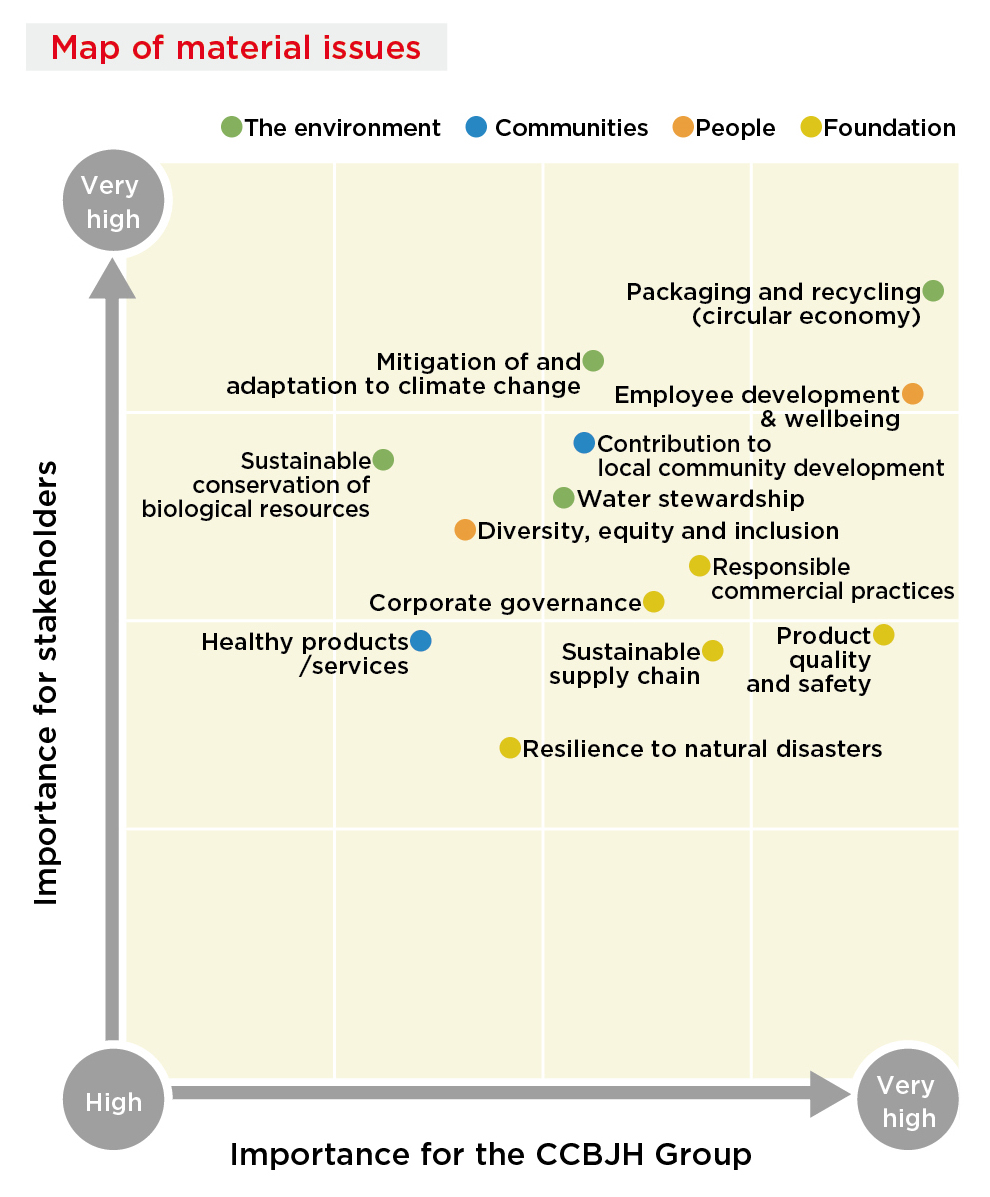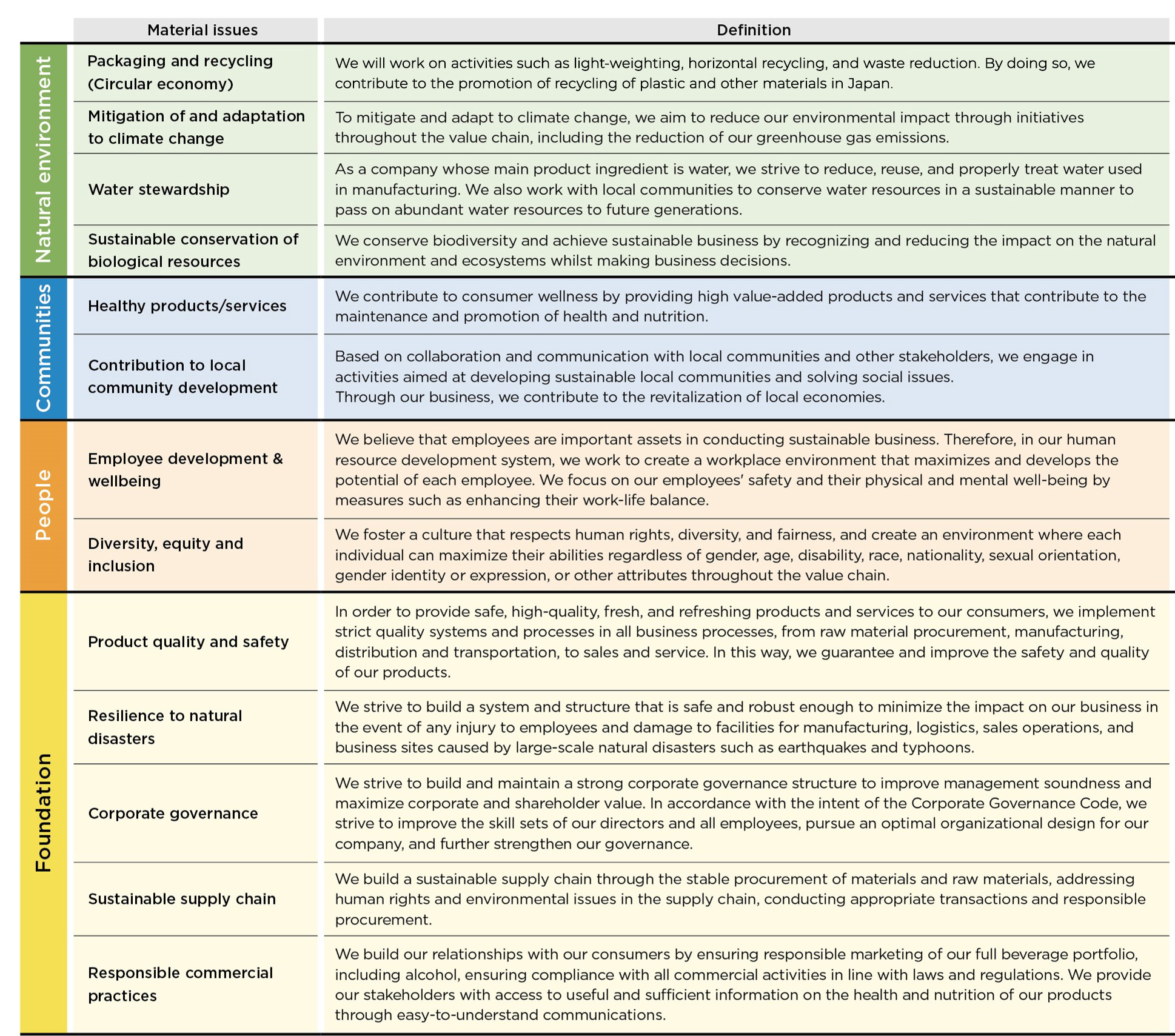Materiality

CCBJH Group's materiality
We see Creating Shared Value (CSV) as the foundation of our sustainability strategy. Our aim is to create economic value through business growth while delivering social value by addressing societal issues. Since identifying our material issues in 2023, we have continued to review their relevance while monitoring for new issues that may arise with changing social conditions.
Process for Identifying Material Issues
Recognizing the current status
To fulfill our mission to “Deliver happy moments to everyone while creating value,” we established a group-wide, cross-divisional project team to identify our material issues. We began by categorizing social issues and identifying our priorities, referring to key issues recognized across the Coca-Cola System in Japan and drawing on a wide range of resources.
These included industry issue surveys, ESG reporting guidelines (GRI, SASB), ESG rating agency reports (MSCI, FTSE), ISO 26000, and government reports. We also incorporated insights from external consultants’ reports and findings from benchmark surveys that include interviews with consumer groups, retailers, NPOs, academic bodies, ESG investors, and other external stakeholders.
Identifying material issues
The project team assessed the identified issues based on their level of importance. From these findings, they grouped and organized issues, conducted social axis evaluations, and drafted a proposal outlining our material issues. An internal evaluation followed, including document analysis to ensure the proposed material issues were comprehensive and appropriate. The team also deliberated draft definitions for each issue. Through this process, we identified and defined 13 material issues specific to our Group, covering the three environmental, social, and governance areas.
- ● Confirming and organizing existing issues being addressed by the Coca-Cola System in Japan
- ● Identifying topics of social and industry attention and importance
- ● Listing of items to be added as material issues
- ● Conducting importance surveys on existing and additional issues
- ● Grouping issues and reorganizing the issue list based on issue granularity
- ● Conducting social axis evaluation in accordance with issue granularity, drafting a proposal for material issues
- ● Organizing and preparing a proposal for material issues and their proposed definitions through internal evaluations, including analysis of our data
- ● Discussing issue granularity and definition within the project team
- ● Selecting 13 key material issues across three categories: Environmental, Social and Governance
- ● Conducting interviews with stakeholders
- ● Conducting interviews with management including the CEO and employee surveys
- ● Scoring importance for the preparation of the proposed map of material issues
Organizing material issues
To evaluate our 13 material issues, we conducted interviews and surveys with ESG investors, NGOs, local governments, management, and employees. We then assigned scores based on their input. For the social axis, we evaluated stakeholder importance using expert opinions and report analysis. For the business axis, we evaluated importance to the Company based on feedback from management and employee surveys. These evaluations were used to create a materiality map. Among the 13 issues, we recognize “packaging and recycling (circular economy),” “mitigation of and adaptation to climate change,” and “employee development & Well-being” as particularly important.

Confirming appropriateness and ongoing review
Based on feedback from stakeholders, our Board of Directors, Executive Leadership Team (ELT*), and Sustainability Committee regularly discuss how to respond to changes in the external environment, as well as newly identified social issues. The group also reviews the relevance of our existing material issues and consider the need to recognize new ones. By continuing these discussions, we aim to realize Creating Shared Value and achieve the goals of our strategic business plan, “Vision 2028.”
* An abbreviation for Executive Leadership Team, referring to the management organization within the CCBJI Group, including the CEO and function heads
Definitions of material issues
To identify the 13 material issues specific to our company we first created a list of issues based on the results of a social axis survey. We then refined definitions through analysis of internal materials. Drawing on input from a cross-divisional project team, we examined the granularity definitions of each issue to develop our own company-specific definitions for material issues. These were then categorized into four major groups: People, Natural environment, Communities, and Foundation. This process clarified the material issues critical to our sustainable growth and allowed us to prioritize efforts to address these issues. Our material issues recognize the importance of and alignment with the Sustainable Development Goals (SDGs), and through our initiatives, we aim to contribute to their achievement.

